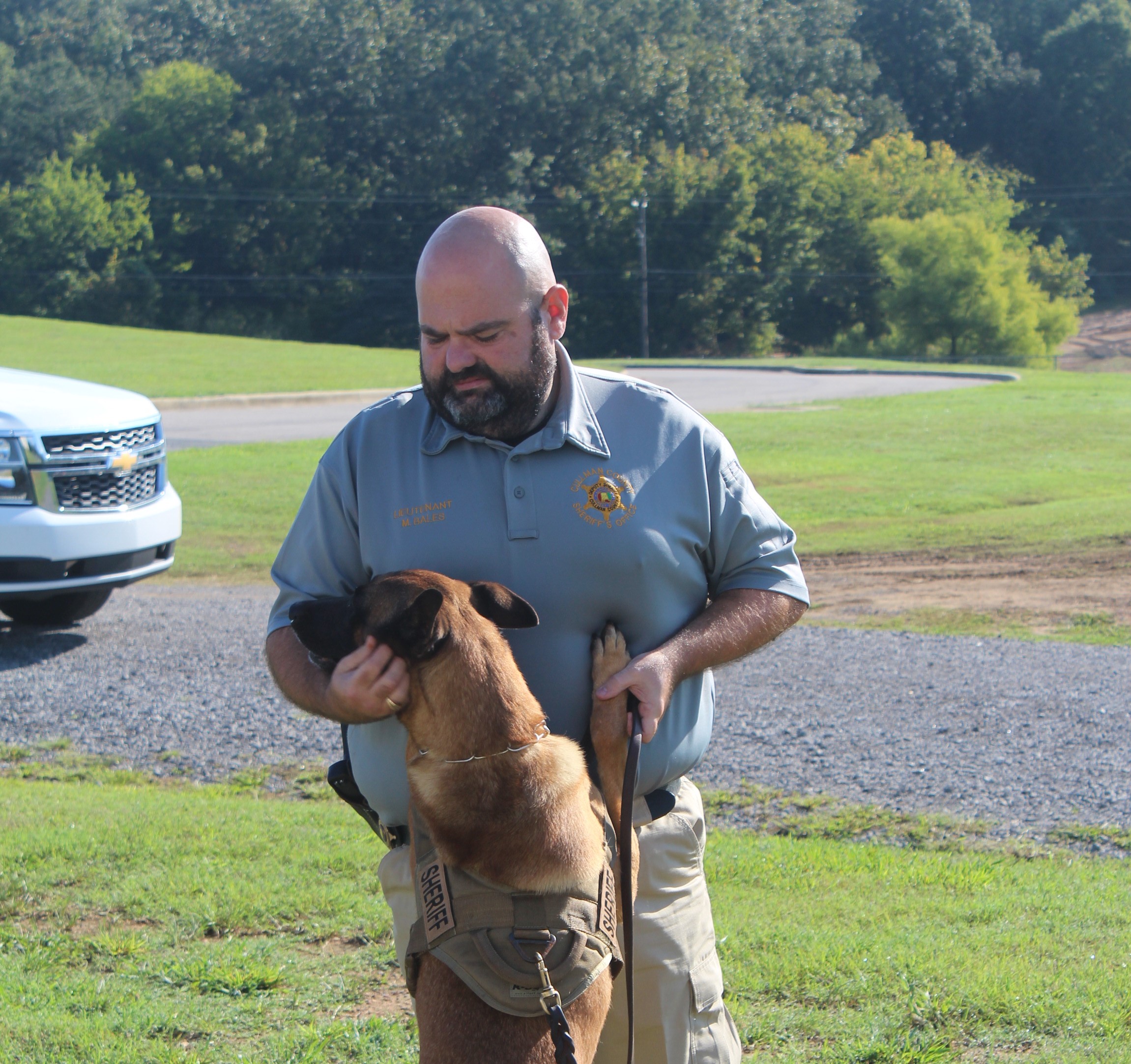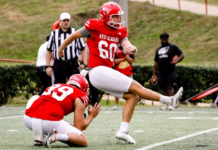Lt. Matthew Bales with his K-9, Tommy, a Belgian Malinois (Christy Perry for The Cullman Tribune)
CULLMAN – K-9 Deputy Tommy was ready to get to work Friday morning as he and his partner, Lt. Matthew Bales, arrived at the Cullman County Sheriff’s Office (CCSO). Tommy is a 5-year-old Belgian Malinois who is one of four trained and certified drug dogs the CCSO currently uses. Two bloodhounds are also trained and certified tracking dogs. Tommy could be considered the K-9 standout as he is certified in both disciplines.
Lt. Bales and Tommy met with The Tribune Friday morning along with Sheriff Matt Gentry to talk about the K-9 program.
Lt. Bales oversees the K-9 drug unit and Lt. Joey Cone supervises the tracking units. Tommy is Lt. Bales’ third K-9 partner.
He explained, “When we began the program in 2003, we were relying on donations. We built the pens ourselves and saw to all the dogs’ needs. Sheriff Gentry immediately made sure to better the program making sure the dogs are taken care of.”
Gentry added, “The programs and the K-9s are a great asset to our department. Fighting drug crimes is a priority, and the dogs have incredible abilities that help us do that. We want to provide the community with the best equipment to be more efficient. That includes the K-9 officers.”
One of the main services the K-9s provide is with the schools. The K-9 deputies are often requested by school administrators to walk the parking lots and school buildings. The K-9s are trained to alert their handlers when they detect marijuana, cocaine, heroin and methamphetamine.
Lt. Bales said, “We usually conduct sweeps at a couple of schools a week. We will be at Cullman High School today and were at West Point yesterday.”
School administrators gather the students’ backpacks for the dogs to sweep. The officers never know which student owns the cars, backpacks or items. To give a better idea of the K-9s’ abilities, Lt. Bales shared a story from a sweep at Cullman High School.
“This was last year,” he said. “The dog alerted us to one car. Later he alerted us to one backpack in a room with other backpacks. Both the car and backpack belonged to the same student.”
The CCSO’s drug dogs are brought in from Belgium and the bloodhounds are from New Market, Alabama.
Lt. Bales explained, “The drug dogs come to us already named. They are assessed and must demonstrate 18 drives before qualifying as a potential K-9 officer. They are called ‘green’ dogs when they arrive. The dog and handler will attend a six-week course to train on detecting narcotics. It’s also a team-building and bonding course for the dog and handler.”
Drives include prey, pack, fight, flight and other responses that help in understanding a dog’s temperament and behavior.
Lt. Bales said of the dogs coming from oversees, “In the U.S., dogs are bred for papers and appearance. In Europe breeders are focused on genetics and behavior, resulting in healthier dogs with good temperaments.”
Both Lt. Bales and Lt. Cone are trained and certified to teach other handlers.
Gentry said, “Our officers continue to go through training with their dogs twice a month. They also maintain their certifications by additional training classes twice a year. The training school is also in New Market and is for dog and handler.”
The dogs are trained using “cross odors” such as cat urine to teach the dogs to ignore other odors while targeting the presence of narcotics.
When the K-9 officers are off duty, they stay with their handlers in their homes. They can work as long as health allows and as long as the dog demonstrates the desire to work.
Lt. Bales said of past K-9s and Tommy, “The dogs want to work. They are high-energy and love doing their jobs. They can get a bit stir crazy if they aren’t worked or exercised often.”
At home, Tommy is a “big baby.” Recently, a small kitten found its way into Tommy’s pen.
Lt. Bales said, “We got the kitten out, but it keeps getting in there. One day, I found Tommy cuddled up with that little kitten. One of the best things about Tommy is he ignores other dogs when they are around. I guess that’s true for kittens, too.”
Gentry and Bales laughed as they recalled a story about another Belgian Malinois Bales had before Tommy, named Max. Max had a habit of relieving himself at inappropriate times.
Gentry laughed, “It wasn’t funny at the time, but we were conducting a youth leadership class at the courthouse and Bales comes in with Max.” Bales interjected, “Well Max decided he would go number two right there!” Gentry added, “IN the courtroom!!”
Gentry is very proud of the K-9 program and its success, saying, “I want to purchase two more dogs for the department. The dogs help in many ways. They can track missing persons or fleeing suspects, search cars and other places to help find illegal drugs, they assist when executing search warrants. If a dog alerts his handler, that establishes probable cause.”
Gentry thanked Dr. Tony Crider, DVM. “Dr. Crider has always been great to our department and our K-9s. He takes care of them and makes sure they are healthy.”
The six K-9 units are:
Drug and Tracking units:
Lt. Bales with Tommy
Drug units:
Deputy Clayton Dew with Delta, a Belgian Malinois
Deputy Cheryl Hawkins with Ammo, German shepherd
Deputy Adam Clark with Figo, Belgian Malinois
Tracking units:
Lt. Cone with AJ, bloodhound
Deputy Moore with Clara Bell, bloodhound
Copyright 2018 Humble Roots, LLC. All Rights Reserved.



















